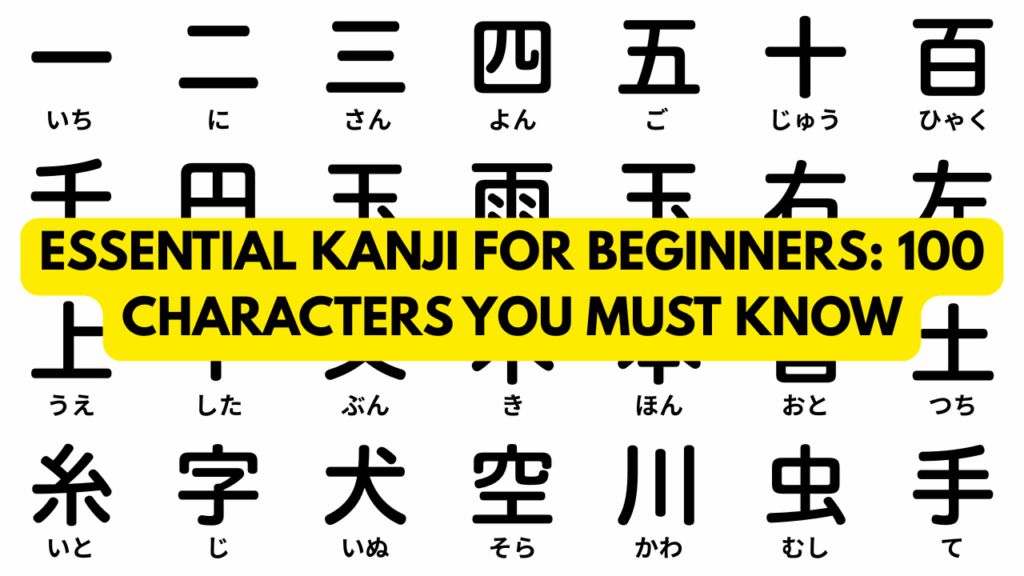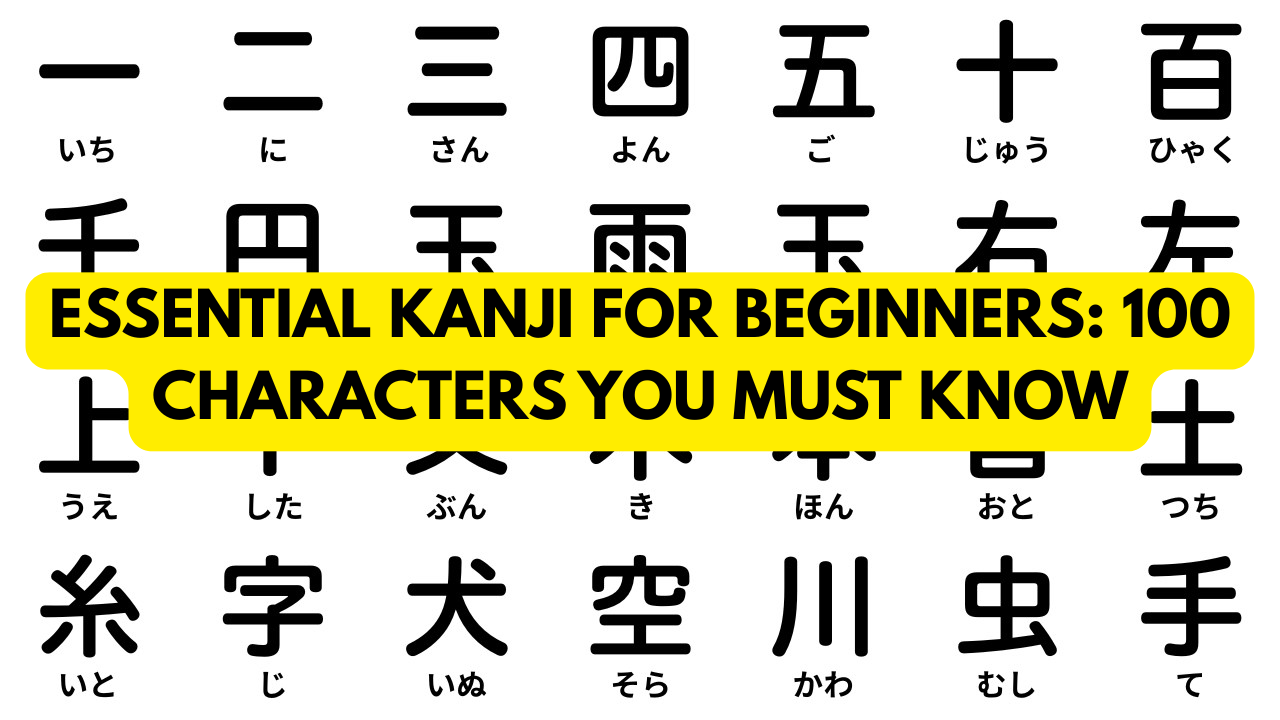
Kanji can feel overwhelming for beginners, but mastering the first 100 characters creates a solid foundation for reading, writing, and passing early levels of the JLPT. These kanji appear frequently in everyday life—on signs, menus, books, and conversations. If you focus on these core characters, you’ll recognize thousands of words because most kanji are combined to form compounds.
This guide covers the importance of kanji, a breakdown of the first 100 beginner-friendly characters, and how to study them effectively without feeling lost.
Why Focus on the First 100 Kanji?
- High frequency: These characters appear in everyday vocabulary and beginner-level JLPT exams (N5–N4).
- Practical use: You’ll read simple texts, menus, and signs more confidently.
- Foundation: Many advanced characters build from these basic forms.
- Confidence boost: Learning a small, useful set motivates you to continue.
Overview Table
| Category | Examples | Why Important | Number (approx.) |
|---|---|---|---|
| Numbers | 一、二、三、十 | Daily life, counting | 10 |
| Days/Time | 日、月、年、時 | Telling time, dates | 12 |
| Directions | 上、下、左、右 | Navigation, signs | 8 |
| People/Body | 人、女、男、手、目 | Everyday words | 15 |
| Nature | 山、川、木、火、水 | Common nouns | 20 |
| Basic Verbs | 食、飲、見、行、来 | Essential actions | 20 |
| School/Places | 学、生、校、本、町 | Study, daily life | 15 |
1. Numbers and Counting
Numbers are among the first kanji learners encounter because they appear everywhere—from prices to dates.
- 一 (one), 二 (two), 三 (three), 四 (four), 五 (five)
- 六 (six), 七 (seven), 八 (eight), 九 (nine), 十 (ten)
- 百 (hundred), 千 (thousand), 万 (ten thousand)
Example: 三人 (さんにん) = three people
2. Days, Time, and Calendar
Understanding time-related kanji is crucial for scheduling, telling time, and reading dates.
- 日 (day/sun), 月 (month/moon), 年 (year), 時 (time/hour), 分 (minute), 週 (week)
- 今日 (きょう) = today, 明日 (あした) = tomorrow
Example: 七時半 (しちじはん) = 7:30
3. Directions and Positions
These kanji appear in signs, maps, and descriptions.
- 上 (up), 下 (down), 中 (middle), 左 (left), 右 (right)
- 東 (east), 西 (west), 南 (south), 北 (north)
Example: 北口 (きたぐち) = north exit
4. People and Body Parts
Kanji related to people and body parts are used in daily conversations and personal descriptions.
- 人 (person), 女 (woman), 男 (man), 子 (child)
- 目 (eye), 口 (mouth), 手 (hand), 足 (foot)
Example: 女の子 (おんなのこ) = girl
5. Nature and Environment
Japanese culture and language are deeply tied to nature, so these kanji appear often.
- 山 (mountain), 川 (river), 木 (tree), 森 (forest)
- 火 (fire), 水 (water), 土 (earth), 空 (sky), 雨 (rain)
Example: 火山 (かざん) = volcano
6. Everyday Actions and Verbs
Action kanji help form the basis of common sentences.
- 行 (go), 来 (come), 食 (eat), 飲 (drink), 見 (see)
- 聞 (listen), 話 (speak), 読 (read), 書 (write), 買 (buy)
Example: 本を読む (ほんをよむ) = read a book
7. School, Places, and Objects
Since many learners are students, school-related kanji are practical and frequently used.
- 学 (study), 生 (life/student), 校 (school), 本 (book)
- 車 (car), 町 (town), 駅 (station), 家 (house)
Example: 学校 (がっこう) = school
Common Mistakes Beginners Make with Kanji
| Mistake | Example | Fix |
|---|---|---|
| Learning kanji in isolation | 木 = tree, but forgets compound 木曜日 (Thursday) | Study kanji with words |
| Ignoring stroke order | Writing 山 randomly | Follow stroke guides for memory |
| Mixing similar kanji | 日 vs 目 | Practice side-by-side comparisons |
| Forgetting readings | 生 = せい, しょう, なま | Learn readings within real words |
| No review system | Forget kanji after a week | Use spaced repetition (Anki, flashcards) |
How to Study the First 100 Kanji Effectively
- Learn with context: Instead of just memorizing characters, always study them within a word. Example: 学 (study) → 学校 (school).
- Use mnemonics: Create stories to remember shapes. For example, 木 looks like a tree.
- Practice writing: Even in the digital age, writing helps reinforce memory.
- Prioritize recognition first: Focus on reading ability before mastering every stroke.
- Review regularly: Use SRS flashcards to avoid forgetting.
Sample Study Routine for Beginners
| Time | Task | Example |
|---|---|---|
| Morning | Flashcards | Review 10 kanji (Anki) |
| Afternoon | Reading | Short graded text with kanji |
| Evening | Writing | Write 5 sentences using today’s kanji |
| Night | Quick Review | Quiz yourself before bed |
Benefits of Learning 100 Kanji Early
- You can read menus, signs, and simple texts.
- JLPT N5 vocabulary becomes much easier.
- Recognizing patterns makes learning advanced kanji less intimidating.
- It creates motivation and momentum to keep going.
3 Best One-Line FAQs
Q1. How long does it take to learn 100 kanji?
A. With daily practice, most learners can master them in 1–2 months.
Q2. Should I learn kanji meanings or readings first?
A. Learn both together, but always in the context of real words.
Q3. Do I need to write kanji by hand?
A. Yes—writing strengthens memory, even if you type more often.

